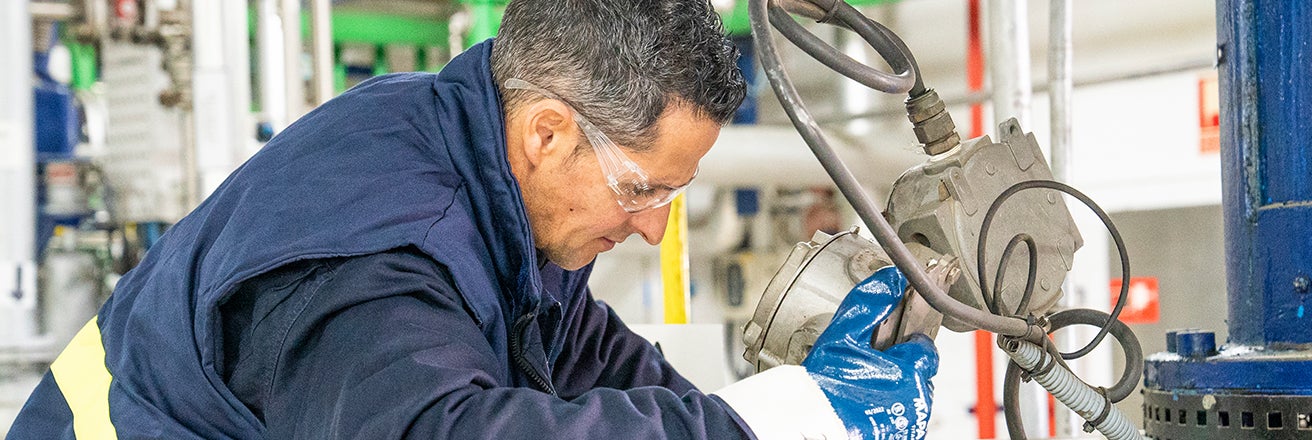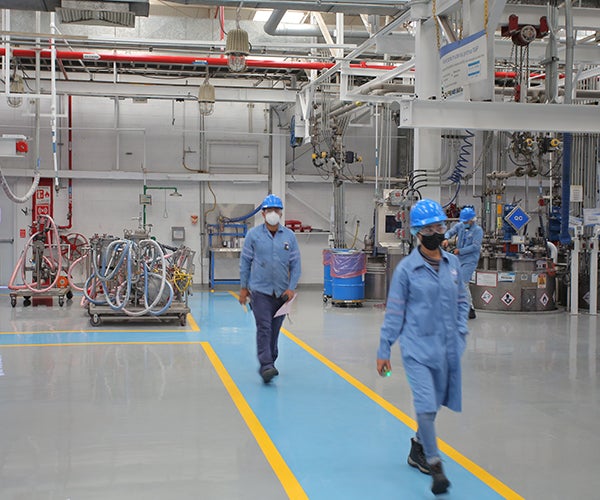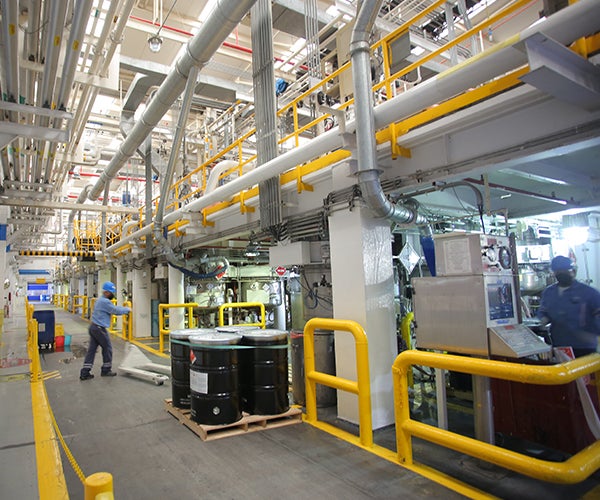The median spill in 2024 was 86,882 pounds, with 96% of spills contained onsite. We had seven substantial spills during the year, which totaled 538,341 gallons (2,037,842 liters). Many of these spills have been attributed to issues with mechanical integrity or work instruction practices.
In 2024, we reduced our overall spill rate from 1.52 to 1.34 spills per 1,000 employees, which excludes the divested silicas and architectural coatings U.S. and Canada businesses. Much of this improvement can be attributed to our increased focus on incident reduction at critical sites, which account for an outsized percentage of our overall spills and releases. Our EHS team engaged directly with floor workers at these sites to identify vulnerabilities and develop additional safety procedures. This proactive engagement translated to significant year over year improvements, with spill rates at our critical sites falling by up to 40%.
PPG facilities employ management practices to prevent spills and releases, including employee engagement activities, training, spill elimination assessments, operational improvements, self-assessments and best practice sharing. We engage with all PPG employees through a job safety analysis (JSA), a systematic process designed to identify potential hazards and develop improved work practices for carrying out a specific task or job operation. This is one of several tools within our EHS Management System that help address causal factors, such as equipment, process or people interactions, to prevent future spills and releases.
PPG launched a steering committee in 2024 to review our approach to managing and reporting on spills. As part of this initiative, we began developing an updated process for calculating our spill rate that is more precise and reflective of how our business runs today. Based on insights from peer surveys and benchmarking, we are also working to refine our process for classifying hazardous chemicals to better align with the global harmonized systems of classification and labeling of chemicals (GHS).
For more detailed information about our ongoing approach to waste management and circularity, see the bottom of this web page.
Multi-year data highlights
Waste disposal
Thousand metric tons
Scroll right to view further data »
| 2024 | 2023 | 2022 | 2021 | 2020 | 2019 |
| Waste generated | 165.15 | 166.35 | 157.69 | 166.39 | 159.70 | 183.48 |
Total waste intensity
metric tons per 100 metric tons of production
| 4.83 | 4.84 | 4.47 | 4.44 | 4.48 | 4.82 |
| Disposed | 86.21 | 87.95 | 83.29 | 88.16 | 89.27 | 107.06 |
Disposal intensity
metric tons per 100 metric tons of production
| 2.52 | 2.56 | 2.36 | 2.35 | 2.51 | 2.81 |
| Waste Recycled | 78.94 | 78.39 | 74.40 | 78.22 | 70.43 | 76.42 |
Disposed waste does not include waste that is recycled, reclaimed or incinerated for energy recovery. Waste generated includes all waste from manufacturing and R&D locations generated as a consequence of the activities involved in the production of our products and services. Data changes from prior reporting reflect adjustments for acquired and divested locations.
Waste figures represent global waste data, excluding waste generated from fire suppression system at Circleville, Ohio, facility.
Waste generated / recycled
Non-hazardous waste
Scroll right to view further data »
| 2024 | 2023 | 2022 | 2021 | 2020 | 2019 |
Generated
thousand metric tons
| 69.74 | 69.61 | 68.29 | 71.71 | 67.78 | 75.90 |
Recycled
percent
| 37% | 39% | 37% | 37% | 34% | 34% |
Disposed
thousand metric tons
| 43.95 | 42.21 | 42.74 | 45.26 | 44.62 | 50.23 |
Hazardous waste
Scroll right to view further data »
| 2024 | 2023 | 2022 | 2021 | 2020 | 2019 |
Generated
thousand metric tons
| 95.41 | 96.74 | 89.40 | 94.67 | 91.92 | 107.57 |
Recycled
percent
| 56% | 53% | 55% | 55% | 51% | 47% |
Disposed
thousand metric tons
| 42.25 | 45.74 | 40.55 | 42.90 | 44.66 | 56.83 |
Disposed waste includes waste that is sent off site for landfill, incineration without energy recovery and physical/chemical treatment. We report our hazardous waste data using the regulatory framework of each country where we operate. Data changes from prior reporting reflect adjustments for acquired and divested locations.
Waste figures represent global waste data, excluding waste generated from fire suppression system at Circleville, Ohio, facility.
Spill release rate
Per 1,000 employees
Scroll right to view further data »
| 2024 | 2023 | 2022 | 2021 | 2020 | 2019 |
| 1.34 | 1.66 | 1.45 | 1.44 | 1.35 | 1.52 |
Waste figures represent global waste data, excluding waste generated from fire suppression system at Circleville, Ohio, facility.






